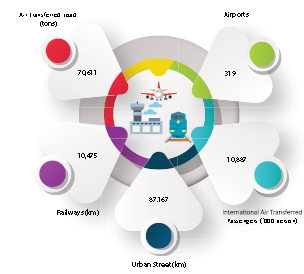

Iran is located in the heart of the Middle East (West Asia), in an area of 1,668,195 km², with 15 neighbouring countries, and has borders with Turkmenistan, Azerbaijan, Armenia, Kazakhstan and Russia (the Caspian Sea) to the North, Afghanistan and Pakistan to the East, Turkey and Iraq to the west and water and land borders with 6 countries including Oman, UAE, Qatar, Bahrain, Saudi Arabia, Kuwait on the Oman Sea and the Persian Gulf to the South. Iran is also a link between the North and the South- the Caspian Sea (the largest lake in the world), the Persian Gulf and the Oman Sea. Iran serves as a unique and strategic location and is considered as the safest country in the region today, being a gateway for economic, cultural and political relations between the East and the West. The main route of the famous Silk Road passes through cities such as Sarakhs, Neyshasbur, Ray, Qazvin, Zanjan and Tabriz in Iran and connects Eastern Asia to Europe.
Iran has one of the longest borders in Western Asia. Iran’s longest common border is with Iraq and its shortest is with Armenia. Except for Russia and Kazakhstan, which have borders with Iran on the Caspian Sea as well as the 6 coastal states of Southern Persian Gulf and the Oman Sea, Turkmenistan border with Iran is 1205 km, Azerbaijan 759 km, Armenia 48 km, Turkey 580 km, Iraq 1609 km, Pakistan 978 km and Afghanistan 709 km.
 Iran's gross domestic product (GDP) in 2017 (fixed rate of 2011) was 6,940,834 billion Rials and economic growth equalled 3.7%. The GDP for agriculture, oil, industries & mines and services accounted for 6.6%, 22.2%, 23.9% and 49.9%, respectively.
Iran's gross domestic product (GDP) in 2017 (fixed rate of 2011) was 6,940,834 billion Rials and economic growth equalled 3.7%. The GDP for agriculture, oil, industries & mines and services accounted for 6.6%, 22.2%, 23.9% and 49.9%, respectively.
Based on the 10 expensive commodities, including oil, gas, coal, forest and timber, gold, silver, copper, uranium, crude iron and phosphate, Iran ranks 5th in the world with rich oil and gas resources after Russia, US, Saudi Arabia and Canada.
Having 130 billion barrels of oil reserves, Iran is the 2nd largest oil-rich country after Saudi Arabia. Iran holds 2nd place after Russia with 950 trillion cubic feet of gas reserves, and owns about 12 important mine and mineral reserves: 8% of Zinc, 3% of the world's lead, 68 types of non-oil minerals, 37 billion tons of discovered reserves, and 57 billion tons of potential reserves. Iran stands in the world's and Middle East top 10 mineral powers.

According to the FAO report, Iran ranks 1st to 20th in the world for production of 25 crops and garden products, ranking 1st in production of pistachio, barberry, caviar, saffron and cumin; 2nd in production of date and watermelon; and 3rd in production of cherry, melon and walnut.
According to the estimates of the World Travel and Tourism Council, Iran's tourism industry accounts for $ 30.7 billion of GDP and ranks 35th out of 185 countries, thanks to the spending by domestic and foreign tourists.
According to the 2016 census, the population of Iran is 79,926,270 million- 74% urban and 26% rural. Population growth rate was at 1.24% and the literacy rate was 87.6%.
Of the total population, 76% was working. The age composition of the working male population was 9% (10-24), 39% (25-39), 25% (25-40) and 9% (55 years and older). Age composition of the working female population was 2% (10-24), 10% (25-39), 5% (40-54) and 1% (55 years and older).

The economic participation rate was 40.5%, based on male and female participation rates of 64.8% and 16.1%, respectively. Rate of employment was 35.6% and employment share in services, industry and agriculture was estimated to be 50.3%, 32% and 17.7%, respectively. The economically working population accounted for 40.5%. The unemployment rate was 12%, with men and women accounting for 69% and 31%, respectively.
The transportation infrastructure in Iran included 319 airports, which handled about 10,887,000 international air passengers and 70,611 tons of consignment annually. The statistics for railroads was 10,475 km and 87,167 km for intercity roads.

The IRI consumer market is 80 million USD. Furthermore, given the technology and amount of domestic production, Iran is able to supply goods to the region's huge consumer market (400-million population) and thanks to Iran's geographical status and access to open waters, exports in terms of international consumption markets can be expanded.
According to the latest report by the Islamic Republic of Iran Customs, Iran's export amounted to 132,300 tons to the value of 46,931 million USD and imports amounted to 38,736 tons to the value of 54,302 million USD. China, the United Arab Emirates, Iraq and the Republic of Korea are Iran’s major export partners, with China, the United Arab Emirates, the Republic of Korea and Turkey are regarded as Iran’s major import partners.
At the time of writing this paper, foreign investment projects in Iran were 1,110 with a total investment volume of 52 billion USD, which have been implemented in various sectors, including services, industry, energy, transportation and communications.
In the 2018 fiscal year, the Iranian stock market grew significantly. The stock market index was estimated at 178659.1, the industry index at 161,030 and the top 50 company index at 7668.3.
